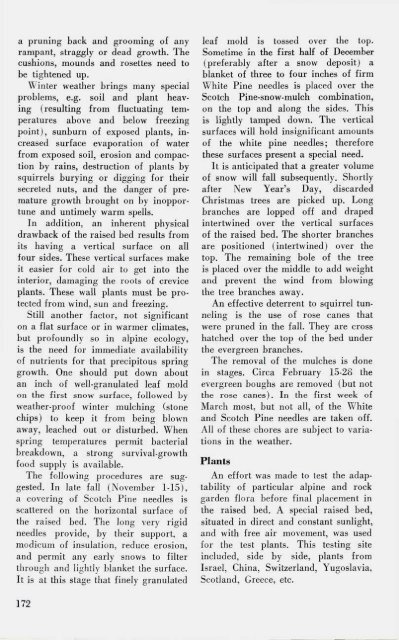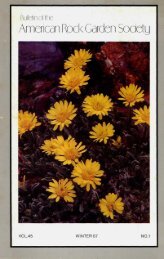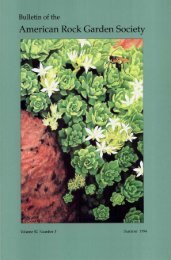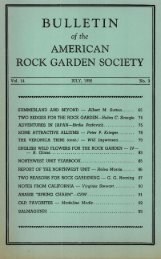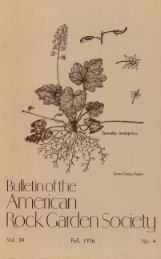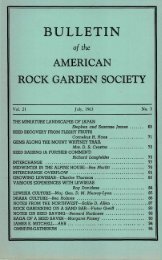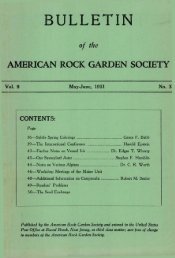Bulletin - Fall 1979 - North American Rock Garden Society
Bulletin - Fall 1979 - North American Rock Garden Society
Bulletin - Fall 1979 - North American Rock Garden Society
Create successful ePaper yourself
Turn your PDF publications into a flip-book with our unique Google optimized e-Paper software.
a pruning back and grooming of anyrampant, straggly or dead growth. Thecushions, mounds and rosettes need tobe tightened up.Winter weather brings many specialproblems, e.g. soil and plant heaving(resulting from fluctuating temperaturesabove and below freezingpoint), sunburn of exposed plants, increasedsurface evaporation of waterfrom exposed soil, erosion and compactionby rains, destruction of plants bysquirrels burying or digging for theirsecreted nuts, and the danger of prematuregrowth brought on by inopportuneand untimely warm spells.In addition, an inherent physicaldrawback of the raised bed results fromits having a vertical surface on allfour sides. These vertical surfaces makeit easier for cold air to get into theinterior, damaging the roots of creviceplants. These wall plants must be protectedfrom wind, sun and freezing.Still another factor, not significanton a flat surface or in warmer climates,but profoundly so in alpine ecology,is the need for immediate availabilityof nutrients for that precipitous springgrowth. One should put down aboutan inch of well-granulated leaf moldon the first snow surface, followed byweather-proof winter mulching (stonechips) to keep it from being blownaway, leached out or disturbed. Whenspring temperatures permit bacterialbreakdown, a strong survival-growthfood supply is available.The following procedures are suggested.In late fall (November 1-15),a covering of Scotch Pine needles isscattered on the horizontal surface ofthe raised bed. The long very rigidneedles provide, by their support, amodicum of insulation, reduce erosion,and permit any early snows to filterthrough and lightly blanket the surface.It is at this stage that finely granulatedleaf mold is tossed over the top.Sometime in the first half of December(preferably after a snow deposit) ablanket of three to four inches of firmWhite Pine needles is placed over theScotch Pine-snow-mulch combination,on the top and along the sides. Thisis lightly tamped down. The verticalsurfaces will hold insignificant amountsof the white pine needles; thereforethese surfaces present a special need.It is anticipated that a greater volumeof snow will fall subsequently. Shortlyafter New Year's Day, discardedChristmas trees are picked up. Longbranches are lopped off and drapedintertwined over the vertical surfacesof the raised bed. The shorter branchesare positioned (intertwined) over thetop. The remaining bole of the treeis placed over the middle to add weightand prevent the wind from blowingthe tree branches away.An effective deterrent to squirrel tunnelingis the use of rose canes thatwere pruned in the fall. They are crosshatched over the top of the bed underthe evergreen branches.The removal of the mulches is donein stages. Circa February 15-28 theevergreen boughs are removed (but notthe rose canes). In the first week ofMarch most, but not all, of the Whiteand Scotch Pine needles are taken off.All of these chores are subject to variationsin the weather.PlantsAn effort was made to test the adaptabilityof particular alpine and rockgarden flora before final placement inthe raised bed. A special raised bed,situated in direct and constant sunlight,and with free air movement, was usedfor the test plants. This testing siteincluded, side by side, plants fromIsrael, China, Switzerland, Yugoslavia,Scotland, Greece, etc.172


